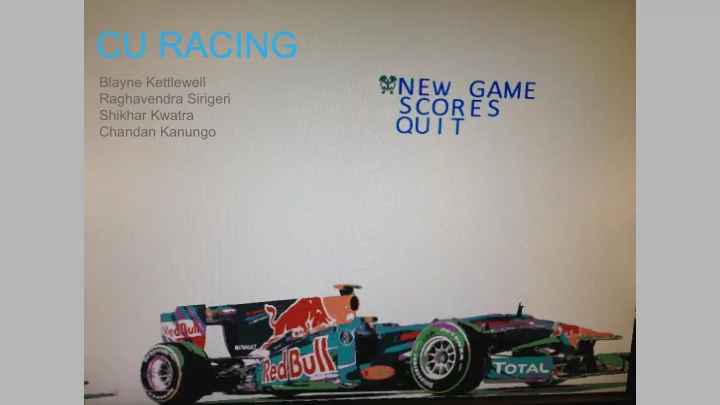

CU RACING Blayne Kettlewell Raghavendra Sirigeri Shikhar Kwatra Chandan Kanungo
Project Concept Evolution Precedent Ideas Early Concept Final Gameplay
Project Goals ● Design a Sprites Graphics engine inspired from the TI TMS9918 ○ Extend texture resolution from 8 pixels to 32 pixels, sprite resolution >= 64 pixels ○ Update colors from Light/Dark pixels to 9 bit colorspace (512 color alternatives/pixel) ● Enable screen scrolling in all directions ● Runtime image programming interface for background patterns ○ No Graphics MIFs! ○ Allows for simplified creation of new game tracks and menus ○ Mitigates limited RAM space on the Cyclone V ● Update VGA resolution to XGA (1024 x 768 60 Hz) ● Implement real-time computation of sprite rotation ● Enable game sounds ● Model car physics and have realistic race dynamics
CU Racing HW Interface Diagram
Sprite Graphics Implementation - Pattern Tables Red Color Red Color Blue Color Pattern Table “Bit 2” Pattern Table “Bit 1” Pattern Table “Bit 0” 0x0000 0x0000 0x0000 Pattern0 Line 0 (U32) Pattern0 Line 1 (U32) Pattern0 Line 1 (U32) Pattern0 Line 1 (U32) Pattern0 Line 1 (U32) Pattern0 Line 1 (U32) ● 9 Independent Dual Port RAMs to Green Color Pattern0 Line 31 (U32) Pattern0 Line 31 (U32) represent 512 Pattern0 Line 31 (U32) Pattern Tables colors/pixel Pattern1 Line 0 (U32) Pattern1 Line 0 (U32) Pattern1 Line 0 (U32) ● Large “register address space” ● 8192 32 bit words / (32 bits/ pattern) ○ 256 patterns 0x1FFF 0x1FFF 0x1FFF
Sprite Graphics Implementation - Pattern Lookup 2D Background Pattern Space Name Table 0x0000 0 1 2 3 4 ... 64 x 1024 Patterns Name0 (U8) ... Name1 (U8) Name2 (U8) Name Name3 (U8) Pattern Index Tables Name4 (U8) Calc. LUTs hCount vCount 0xFFFF
Sprite Graphics Implementation - Movement ● Coarse and fine grain movement ○ 32 pixels “nameOffsetX/Y” ○ 1 pixel “pixelOffsetX/Y” ● Updated synced to VSYNC of VGA ● Unsigned offsets were a non-ideal design choice ○ Made movement more complicated than necessary ● Reasonably smooth movement, still isolating a few bugs Field of View
Programmatic Map Generation 0 0 grassYellow.png 0 straightGrassLeft.png 0 0 roadTileWithoutLine.png 0 roadTileWithLine.png 0 straightGrassRight.png 0 tree-0-0.png 0 tree-0-1.png 0 0 tree-1-0.png 7 tree-1-1.png 0 grassYellow.png 8 grassYellow.png 0 1 grassYellow.png 2 grassYellow.png 3 grassYellow.png 2 grassYellow.png 4 0 grassYellow.png 0 grassYellow.png 0 grassYellow.png 0 grassYellow.png 0 grassYellow.png 0 0 0 0 “trackXNames.txt” “trackXPatterns.txt”
Sprite Rotation - Rotation Matrix Approach d a e R M A R S d e t a d n p o U i t c e r i d Wikipedia: Rotation Equation .
Sprite Rotation - Development Approach 1) High Level Software 2) System Verilog implementation 3) Signal-Tap II Debugging Algorithm POC + Modelsim Validation of hardware realized solution
Lessons Learned ● Teamwork in an academic setting is difficult ○ Different experience levels, time commitments, interest etc. etc. ● Quartus II software has many quirks ○ X <= Y can yield unexpected results, sometimes it’s better to manually index the bits you care about ○ Parameter constants can be different in the RTL viewer from what you would expect based on your System Verilog code ○ Warnings are almost too forgiving, some may be better to fail the compilation (net inferrence) ● Module based encapsulation is critical to help debug RTL code and allow for reasonable viewing of the system interconnections ● Signal Tap II is a crucial debugging tool, without it our project would have missed several desired deliverables. ● Open source drivers can be unpredictable to work with and be non-trivial to build for an embedded target
Recommend
More recommend